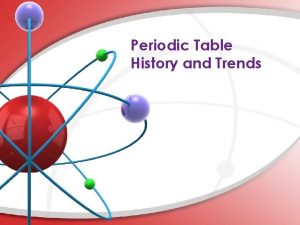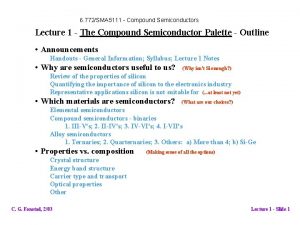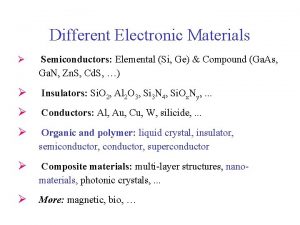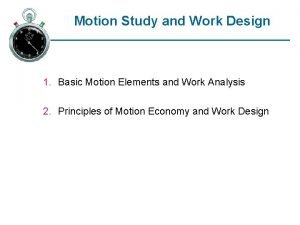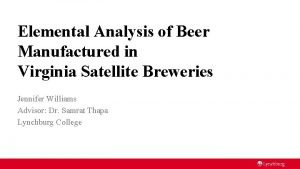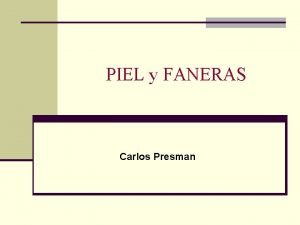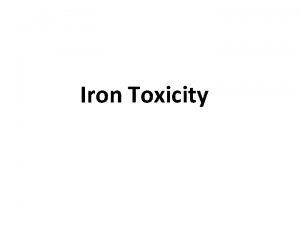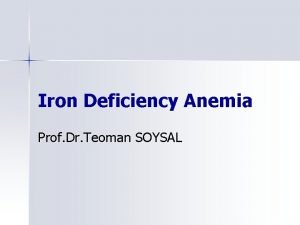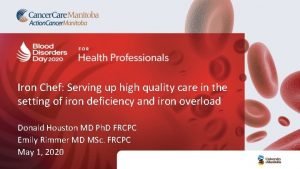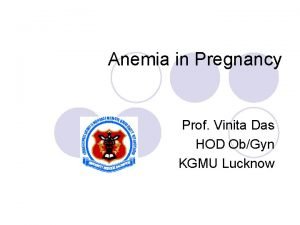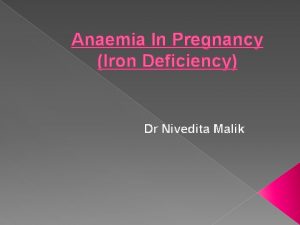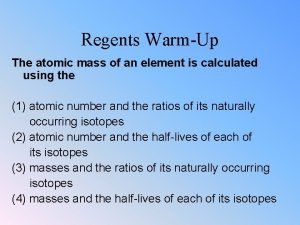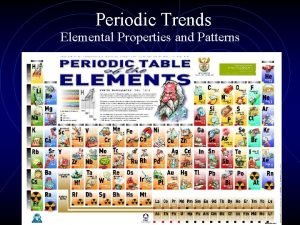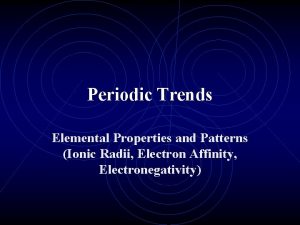Periodic Trends Elemental Properties and Patterns The Periodic

























- Slides: 25

Periodic Trends Elemental Properties and Patterns

The Periodic Law • Atoms with similar properties appear in groups or families (vertical columns) on the periodic table. All have the same number of ve-, which governs their chemical behavior

Periodic Trends • Radius is the distance from the center of the nucleus to the “edge” of the electron cloud.

Atomic Radius • Since a cloud’s edge is difficult to define, scientists use half the distance between the nuclei of 2 bonded atoms.

Covalent Radius • Two Br atoms bonded together are 2. 86 angstroms apart. So, the radius of each atom is 1. 43 Å. 2. 86 Å 1. 43 Å

Atomic Radius • In a vertical column: Smaller at the top to larger at the bottom of the family • With each step down the family, we add an entirely new ‘shell’ to the electron cloud, making the atoms larger with each step.

Atomic Radius • The trend across a horizontal period is less obvious. • What happens to atomic structure as we step from left to right? • Each step adds a proton and an electron (and 1 or 2 neutrons). • Electrons are added to existing shells or sublevels.

Atomic Radius • The effect is that the more positive nucleus has a greater pull on the electron cloud. • The nucleus is more positive and the electron cloud is more negative. • The increased attraction pulls the cloud in, making atoms smaller as we move from left to right across a period.

Effective Nuclear Charge • What keeps electrons from simply flying off into space? • Effective nuclear charge is the pull that an electron “feels” from the nucleus. • The closer an electron is to the nucleus, the more pull it feels. • As effective nuclear charge increases, the electron cloud is pulled in tighter.

Atomic Radius • Here is an animation to explain the trend. • On your help sheet, draw arrows like this:

Shielding • As more shells are added to atoms, the inner layers of electrons shield the outer electrons from the nucleus. • The effective nuclear charge (enc) on those outer electrons is less, and so the outer electrons are less tightly held.


Ionization Energy • If an electron is given enough energy to overcome the effective nuclear charge holding the electron in the cloud, it can leave the atom completely. • The atom has been “ionized” or charged. • The number of protons and electrons is no longer equal.

Ionization Energy • The energy required to remove an electron from an atom is ionization energy. (measured in kilojoules, k. J) • The larger the atom is, the easier its electrons are to remove. • Ionization energy and atomic radius are inversely proportional.

Ionization Energy

Ionization Energy (Potential) • Draw arrows on your help sheet like this:

Electron Affinity • Electron affinity is the energy change that occurs when an atom gains an electron (also measured in k. J). • The neutral atom’s likelihood of gaining an electron • EA increases as more electrons are added to each orbital

Electron Affinity • Your help sheet should look like this: + +

Electronegativity • Electronegativity is a measure of an atom’s attraction for another atom’s electrons. • Generally, metals are electron givers and have low electronegativities. • Nonmetals are electron takers and have high electronegativities. • What about the noble gases?

Electronegativity • Your help sheet should look like this: 0

Overall Reactivity • This ties all the previous trends together in one package. • However, we must treat metals and nonmetals separately. • The most reactive metals are the largest since they are the best electron givers. • The most reactive nonmetals are the smallest ones, the best electron takers.

Overall Reactivity • Your help sheet will look like this: 0

Ionic Radius • Cations are always smaller than the original atom. • The entire outer shell is removed during ionization. • Conversely, anions are always larger than the original atom. • Electrons are added to the outer shell

Cation Formation Effective nuclear charge on remaining electrons increases. Na atom 1 valence electron 11 p+ Valence elost in ion formation Result: a smaller sodium cation, Na+ Remaining e- are pulled in closer to the nucleus. Ionic size decreases.

Anion Formation Chlorine atom with 7 valence e 17 p+ One e- is added to the outer shell. Effective nuclear charge is reduced and the e- cloud expands. A chloride ion is produced. It is larger than the original atom.
 Nuclear charge definition
Nuclear charge definition Periodic trends in elemental properties
Periodic trends in elemental properties Periodic trends in elemental properties
Periodic trends in elemental properties Trends of the periodic table
Trends of the periodic table Periodic trends in properties of elements
Periodic trends in properties of elements How to find out group and period of an element
How to find out group and period of an element A visual aid used to show statistical trends and patterns
A visual aid used to show statistical trends and patterns A visual aid used to show statistical trends and patterns.
A visual aid used to show statistical trends and patterns. Quarternaries
Quarternaries Elemental and compound semiconductors
Elemental and compound semiconductors Associations and correlations in data mining
Associations and correlations in data mining Principles of motion economy
Principles of motion economy Elemental analysis of beer
Elemental analysis of beer Unidad elemental
Unidad elemental Molusco contagioso lesion elemental
Molusco contagioso lesion elemental Elemental iron dose
Elemental iron dose Elemental iron dose
Elemental iron dose Elemental iron dose
Elemental iron dose Nutrisi enteral dan parenteral
Nutrisi enteral dan parenteral Característica de educación física
Característica de educación física Cases of iron deficiency anemia
Cases of iron deficiency anemia Elemental iron dose
Elemental iron dose Elemental states
Elemental states Que es la gimnasia elemental
Que es la gimnasia elemental Elemental balance in bioprocess
Elemental balance in bioprocess Steady state vs equilibrium
Steady state vs equilibrium




